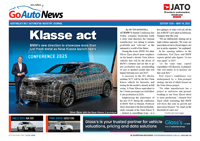New models - Honda - Jazz - 5-dr hatch rangeFirst drive: Honda changes its Jazz tuneHatched: MkII Jazz is sharper, bigger and safer, but lacks ESC and is thirstier. Honda adds dynamics, space, quality and safety to its all-new light-car, but not ESC29 Aug 2008 AFTER six years and 51,000 sales in Australia, Honda has reinvented its Jazz light-car with an all-new body and interior, revised mechanicals and significantly improved refinement, dynamics, safety and space levels. However, electronic stability control (ESC) will not be available for at least one year, and the expected volume-selling Jazz VTi leaps by $1000 to $19,170 as a manual and $21,490 for the auto. Offsetting this in the Thai-built Jazz is the implementation of standard side and curtain airbags on the VTi and VTi-S. They are part of a $1000 safety pack on the entry-level GLi, which keeps its predecessor’s $15,990 pricing, while all models also gain rear-wheel disc brakes, larger wheels and more equipment. Virtually nothing has been carried over from before, but the old Jazz’s front-wheel drive configuration, tallboy five-door hatchback design and flush-with-the-floor ‘Magic Seat’ rear seat-folding arrangement (made possible by a centrally-mounted fuel tank) remains. With 2.5 million sales worldwide, the outgoing Jazz was an unexpected global success despite having been designed primarily for Japan, so the new one has grown in almost every dimension as it takes on a more pivotal role for Honda – particularly in the North American and European markets. So the company refined its ‘Maximum Man, Minimum Machine’ philosophy to vehicle design with the ‘Super Forward Cabin’ approach for the 2009 Jazz. Increases abound, in the new car’s 3900mm length (+55mm), 1695mm width (+20mm) and 2500mm wheelbase (+50mm), to front and rear tracks that are 35 and 30mm wider than before, at 1492 and 1475mm respectively. Only the 1525mm height is shared. The second-generation Jazz now boasts a Mercedes-Benz A-class-style monospace silhouette, with A-pillars that are positioned more forward than before to liberate as much cabin space as possible. The resulting interior dimension changes, which Honda claims give the Jazz medium-car space, include: 30mm more cabin width 44mm more front shoulder room 43mm more rear shoulder room 40mm more rear knee room and 10mm more rear head clearance. New, larger front seats are now also “medium sedan sized” and so accommodate wider posteriors, yet the seatbacks are scalloped so the seats don’t have to slide forward for the split rear seats to clear them when folded down into their floor cavity. Furthermore, the rear seats are now 20mm wider, 15mm deeper, have 10mm thicker cushions, and include head restraints that sit flush with the top of the backrest to assist reversing vision and turn the rear-seat folding procedure into one simple movement. However, with all seats erect, the Jazz offers 43 litres less luggage capacity than before, at 337 litres, while a full-sized spare wheel lives underneath the floor there is also 848 litres available to the window line in two-seater ‘utility’ mode. Recline the front passenger seat and a 2400mm-long object such as a surfboard can be accommodated, or – from the rear of the front seat – a 1720mm object (say, Tom Cruise lying down). A 1280mm tall pot plant can be transported with the rear cushion folded vertically. A low hatch opening means that heavy objects need only be lifted 605mm from the ground, while wider opening doors have also been incorporated, with the rear pair now arcing to an 80-degree angle (and having two stop settings along the way) for easier entry/egress and access. Forward vision is aided by A-pillars that are 20mm narrower, quarter windows that are three times larger than before and a windscreen that is 20 per cent bigger due to its base being positioned 120mm further forward, while the upper windscreen edge is set further back into the roof. The driver now has a tilt/telescopic steering column with more adjustment, and a left footrest, while the perceived quality of trim and materials has increased due to the use of different grains and textures. The Jazz’s body is far stronger than previously, thanks to the adoption of Honda’s Advanced Compatibility Engineering structure, which includes a load-distributing frame for better crash safety as part of the company’s G-Force Control (G-CON) technology. Honda’s internal crash-test regime suggests that – fitted with the side and curtain airbags that are a $1000 option the base GLi but standard on the rest – the new car should score a five-star Euro NCAP crash safety result. However, unlike the pioneering Hyundai Getz and latest Mazda2, ESC won’t be available on Australian-bound Jazzes for some time, so a four-star Australian NCAP result is the best that the 2009 model will achieve. With its engineering department stretched, Honda is still developing an ESC system for Australia, even though it is offered on other Jazz variants with different mechanical configurations abroad, with an estimated arrival time slated for sometime in 2010. Class-leading pedestrian-impact scores are also on the cards, thanks to Honda’s diligence in reducing potential bonnet, bumper and wiper-striking related trauma. Still on safety, increased reinforcements like an additional lower member bolsters rigidity, which, in turn, makes for a better riding and more dynamic driving experience and greatly reduces noise, vibration and harshness transmission. For example, the interior is a claimed 4dB quieter than before, helped by the implementation of sound-absorbing material in the roof, carpet and dashboard. Honda’s chief engineer of product development Toshiyuki Harada told GoAuto that over 90 per cent of the new Jazz’s platform is new, with only the fuel tank and “a few bolts” carried over from before. Extensively revised versions of the previous car’s McPherson strut front and H-shaped torsion beam rear suspension systems have been employed, with increased wheel travel via larger springs incorporated to address the old Jazz’s brittle ride. Improving steering, handling and roadholding qualities were further goals for the new car. To that end, the GLi gains an inch in wheel diameter, while – at 16 inches – the VTi and VTi-S boast wheel and tyre packages that are two inches larger than before. Steering is via a new design electric rack-and-pinion set-up, for more directness and linearity (though, at 9.8 metres, the turning circle is larger than before on most models), while four-wheel disc brakes – with modifications to the brake master-cylinder for improved performance and feel – are now standard Jazz fare. Speaking of performance, as before, two single overhead camshaft (SOHC) four-cylinder engines are offered. Both are Euro IV emissions rated and run on 91 RON standard unleaded petrol. The GLi uses a variation of the old 1.3-litre unit, but gains Honda’s i-VTEC ‘intelligent’ variable valve timing technology in lieu of the old twin-spark i-DSI system. Among its features is an ability to deactivate one valve while at idle to conserve fuel. This 1339cc engine produces 73kW of power at 6000rpm and 127Nm of torque at 4800rpm – representing a rise of 12kW and 8Nm the old 1.3-litre engine it replaces. Meanwhile, the revised 1.5-litre 16-vavle engine in the VTi and VTi-S delivers 88kW at 6600rpm (up from 81kW) and 145Nm at 4800rpm (previously 143Nm). Honda says this engine provides best-in-class power output. However, the new Jazz’s official combined average fuel consumption figures have also risen. The 1.3 five-speed manual GLi returns 5.8 litres per 100km – up 0.1L/100km – while the automatic’s 6.6L/100km represents a significant 0.8L/100km jump. It’s the same story on the carbon dioxide emissions front, with the new 1.3 model’s 138/157 grams per kilometre output for the manual/automatic respectively falling short of the old car’s 135g/km and 138g/km outputs. Similarly, the 1.5’s 6.4L/100km (manual) and 6.7L/100km (auto) outcomes are 0.4 and 0.7L/100km worse than before, as are the 151g/km and 159g/km CO2 readings (previously: 142-144g/km). Honda’s decision to scrap the old car’s continuously variable transmission (CVT) for a conventional five-speed automatic gearbox on grounds of improved response and driveability is one reason. The others relate to the new Jazz’s significantly improved crash-test performance and refinement levels, as well as its increase in overall size, which result in a 50-60kg average weight gain. Nevertheless, Honda says the new Jazz’s real-world fuel consumption is actually virtually on par with the old car, and better in a CVT-versus-automatic comparison when cruising on the highway. The up-spec VTi-S auto also comes with steering wheel paddle shifters. Honda says that considering how much bigger, stronger and quieter the latest Jazz is, its 1065kg (GLi manual) to 1125kg (VTi-S auto) kerb mass figures are a commendable achievement. Like the latest Accord and Civic, improved recyclability has figured in the Jazz’s makeup, with big drops in the use of poly vinyl chloride, lead, hexavalent chromium, mercury and cadmium. What the Honda has is more standard equipment, including dual front airbags, an anti-lock brake system (ABS)with electronic brake-force distribution (EBD), air-conditioning that's more efficient than before, remote central locking, 10 cup-holders, power windows and mirrors, five head restraints, a CD audio system with MP3 compatibility and auxiliary outlet, and a full-sized spare wheel. The aforementioned side and curtain airbag safety pack also adds a trip computer and a speed alarm on the GLi. Honda says it benchmarked the Volkswagen Polo for chassis ‘behaviour’ and comfort, with the Peugeot 207, Toyota Yaris and Renault Clio also used. About 12,000 Jazz sales are expected for 2009, with the VTi accounting for around 65 per cent and the GLi approximately 25 per cent. More than half the volume will be made up of automatic models.
Jazz pricingMotor industry news |
|
||||||||||||||

































Facebook Twitter Instagram